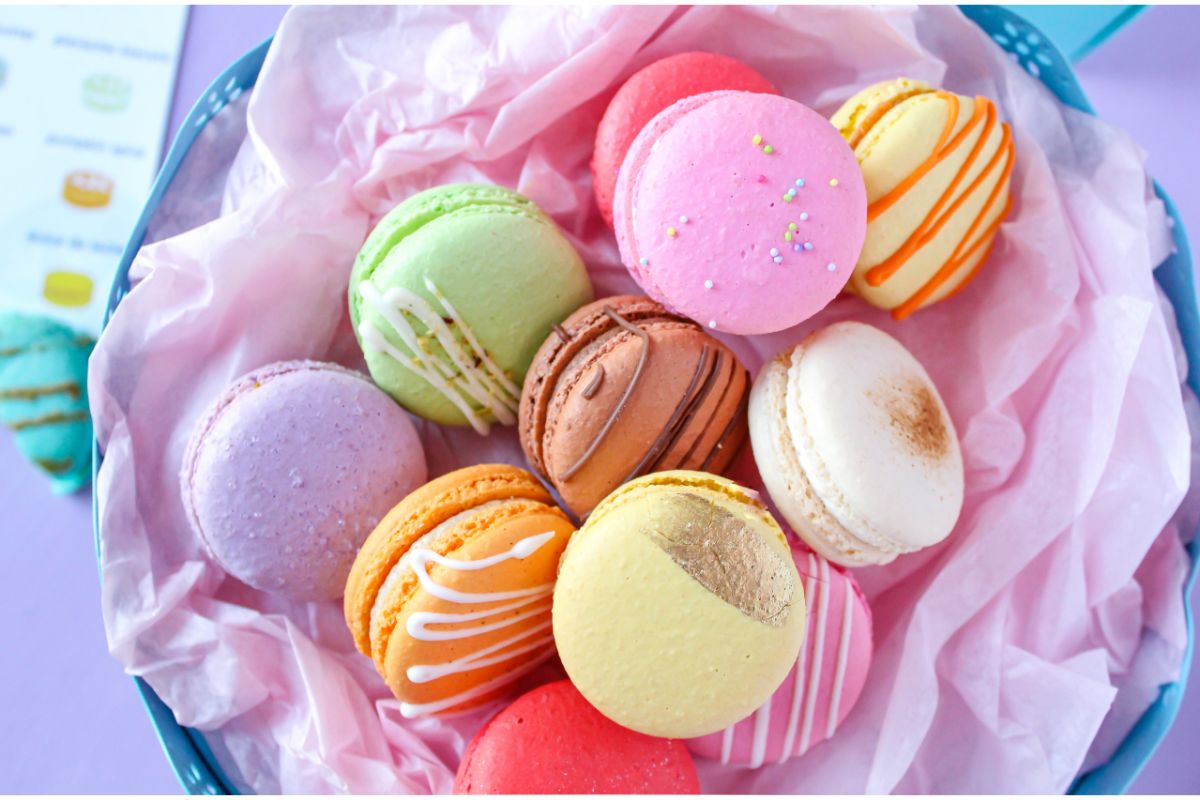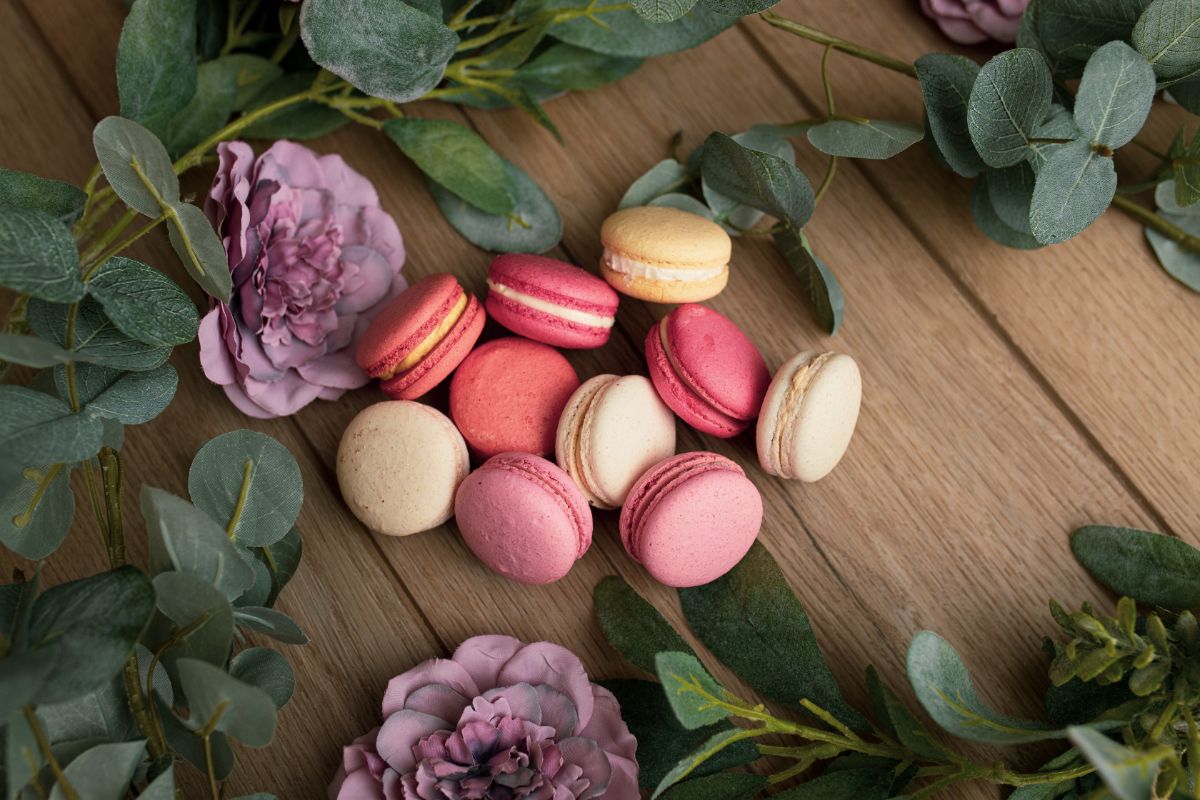French macarons are an elegant and delicious treat, but they are notoriously difficult to make.

Many people struggle to get them even in size, to prevent cracking, to stop the bottoms from being sticky, or they end up overcooking them. If you are experiencing these same issues then don’t worry, there are things that you can do to improve your macarons.
This guide will take you through the most common mistakes made during the process of baking macarons, and how to avoid them. Keep reading to find out how to make the perfect macarons every time.
What Are Macarons?
A French Macaron is a very delicate cookie. It is made up of two macaron shells sandwiched together with a creamy filling. They come in lots of different flavors and colors.
Once you become confident with the process of making French Macarons, you can experiment with different flavor combinations. You can use one flavor for the shells and another for the cream filling.
How Do You Make Macarons?
There are three different types of macaron – Swiss, Italian and French. We are going to be focusing on the classic French Macaron.
The standard flavor is plain almond, which is made from egg whites, cream of tartar, fine sugar, fine almond flour, confectioner’s sugar and food coloring.
The basic method for making macarons is to combine the cream of tartar with the egg whites until soft peaks form. Add the fine sugar and continue beating until glossy peaks form.
Add the gel food coloring and then set the mixture aside. In a separate bowl, combine the confectioners sugar with the almond flour, then fold in the previous mixture.
Keep folding and working the batter until it is smooth and glossy and ready to pipe. Pipe the mixture onto a prepared baking tray in neat circles, and bake until done. Once they are baked, you need to let them dry out. You can then make the filling and sandwich them together.
See here for a full recipe.
The Perfect French Macaron
There are certain things that you should aim for when you make a French Macaron:
- Shape – They should be a perfect circle
- Texture – The shells should be crunchy on the outside and slightly chewy in the middle – they should never be crumbly. The top of the shells should be nice and shiny.
- Feet – There should be a slightly ‘ruffled’ or skirt around the edges from the cooking process. This is called the foot of the macaron
- Collar – There should be a visible collar around the base
Common Problems With Macarons

Here are some common issues people face when they try to make macarons, and why those problems have occurred.
Why Are My Macarons Too Cracked?
Cracked macarons can be caused by a number of factors:
- Under Whipped Meringue – When you combine the egg whites with the sugar you may not have whipped it enough
- Food Coloring – You may have added too much food coloring
- Oven Temperature – You might have cooked the macarons at a temperature that was too high
- Resting – When the macarons have finished baking you need to let them rest and gradually cool down. If they cool down too quickly they will retract which causes cracking. You also need to let them fully dry out before you start fiddling with them, or they could crack
Why Are My Macarons Too Porous?
If you macarons are too porous then you probably made one of these mistakes:
- Broken Meringue – If there was a any fat or grease residue your mixing bowls or mixer then it can compromise the texture of the meringue and cause it ti split
- Under Whipped Meringue – If you don’t whip the sugar and egg whites enough then your macarons could be porous
- Almond Flour – If you are using almond flour that is not fine enough then it could be greasy which will impact the meringue texture
- Cocoa – If you are making chocolate macarons then too much cocoa can cause them to be porous
Why Are My Macarons Flat And Crispy?
Here are the likely causes of flat and crispy macarons:
- Over-mixing – when you combine the meringue with the rest of the ingredients it is possible to overwork the batter. This beats out all of the air and results in flat macarons
- Food Coloring – If you are using food coloring and you add too much then it can make the mixture too runny which leads to flat shells
- Oven Temperature – If the oven temperature is too high then you shells will be far too crispy and flat
Why Are My Macarons Too Hollow?
Hollow macarons are caused by these mistakes:
- Mixing – Both under mixed and over mixed batter can result in hollow shells. That is why it is so important to get that part of the recipe right
- Oven Temperature – If the oven temperature is too low then the macarons won’t cook properly which could lead to large air bubbles and hollow parts. If the oven temperature is too high then the macarons will dry out and be hollow. You need to get the temperature just right
- Resting – The macarons need to rest and dry out for the right amount of time, otherwise they could end up being hollow
Why Are My Macarons Too Bumpy?
Bumpy macarons are one of the easier issues to fix:
- Mixing – If you under mix the batter then you won’t have worked all the lumps out, resulting in a bumpy shell. Make sure the batter is smooth and shiny before you pipe it
- Sifting – It is important to sift your dry ingredients before you add them to the mixture – the sugar and the almond flour. Almond flour tends to clump together, so you might want to push it through the sieve using the back of a metal spoon to make sure all of the lumps are out.
Why Are My Macarons Too Soft?
There are several reasons why your macaron shells might be soft rather than crunchy and chewy:
- Ingredients – Some people use cornstarch in their french macarons. This is not the right process and will lead to a soft texture
- Under Whipped Meringue – If you underwhip the meringue then it will not form stiff peaks. This means that the macaron shells will be soft rather than chewy and crunchy
- Underbaked – If you under bake the macaron shells then they will not develop the crunchy outer edge that they need
Why Are My Macarons Bubbly?
Air bubble can ruin the appearance of your macarons and they are usually caused by:
- Over Whipped Meringue – If you over whip your meringue then you will introduce too much air into the mixture which may result in air bubbles on your macaron shells
- Macaronage – When you combine the meringue mixture with the rest of the ingredients, you need to fold it in gently and then continue to patiently work the batter. If you rush this step and are too vigorous then you will get air bubbles on your shells
- Tray Tapping – You need to tap the trays before and after you bake the macaron shells to pop any air bubbles they may have formed
Why Do My Macarons Have Ruffled Feet?
You want a small ruffled skirt around the macaron – too much ruffle is usually caused by:
- Over Whipped Meringue – Over whipping the meringue can introduce too much air into the mixture which leads to excessive ruffling
- Over mixing – If you overmix the batter then this can lead to too much ruffling
- Oven Temperature – If the oven temperature is too high it can make the skirt of the shell too pronounced
Why Do My Macarons Have No Feet?
If you macarons have no feet then you made one of these mistakes:
- Under Whipped Meringue – An under whipped or split meringue will prevent feet from forming
- Wet Batter – If your batter was too wet and runny then the ruffled skirt won’t form during baking
- Oven Temperature – If the oven temperature is too low then your shells won’t have any feet
Top Tips For Making Perfect Macarons
Follow these tips if you want to make sure that your macarons come out perfectly every time.
- Humidity – Choose a dry day to bake your macarons. If you try to make them on a humid day then you will struggle to dry out the shells properly
- Egg Whites – Refrigerate your egg whites for 24 hours, and then bring them up to room temperature before using them
- Macaronage – Macaronage is the process of working the batter until it is smooth and shiny, ready for piping. Do not rush this step and make sure you do it properly as it makes a big difference.
- Mixing Bowls – It is better to use metal or glass mixing bowls rather than plastic ones
- Lemon Juice – Use vinegar or lemon juice to wipe down your mixing bowls and beater to remove grease and fat residue from previous use. This will help to prevent the texture of the meringue from being compromised.
- Instructions – Follow the instructions carefully and exactly – you cannot ‘wing it’ with macarons!
Summary
Macarons can be quite a daunting task for a baker, but with this troubleshooting guide you will be well on your way to making the perfect macaron.
- How To Reheat A Cheesesteak - November 5, 2023
- What Are Three Must Have Kitchen Knives? - September 22, 2023
- How To Protect Edges Of Pie Crust - June 15, 2023








